Graduation at Dopple
For my graduation project at Windesheim University of Applied Sciences, I conducted a research study focused on the consumer acceptance of fully wireless portable audio solutions., completed in January 2018. he project was conducted at Dopple B.V. and explored the introduction of “left/right-split” wireless earphones, which were popularized by Apple in 2016. These earphones consist of two separate earpieces that provide users with unprecedented freedom of movement. My role in the project was to understand how such a product could achieve higher consumer adoption, especially given the rapid technological advancements and the evolving expectations of users.
The aim was to dive deep into consumer preferences and barriers to adoption, particularly focusing on elements like usability, comfort, social influence, and trust in technology. The process was structured in several key phases: first, I conducted a literature review to understand the existing landscape and identify initial consumer concerns. Next, I moved on to qualitative research using focus groups to gather in-depth insights into user needs and behaviors. Finally, I performed quantitative validation through surveys, involving 70 participants, to ensure the robustness of my findings. Each phase built upon the previous one, allowing me to refine my approach and focus on the most critical factors influencing consumer acceptance.

Persona’s
An important aspect of the project was the use of personas to ensure that the consumer insights were well represented throughout the design process. Based on the initial research, I developed detailed personas that captured the characteristics, needs, and behaviors of different segments of the target audience. These personas included profiles such as the “Digital Nomad,” who values portability and seamless connectivity, and the “Fit Enthusiast,” who prioritizes comfort, secure fit, and ease of use during physical activities. Using these personas, I was able to empathize with various user types, guiding design decisions that catered to their unique requirements. The personas played a critical role in testing and refining features, ensuring that the final product addressed real consumer pain points effectively.





Ideation
The ideation phase in this project was performed through a combination of divergent and convergent creative processes. Initially, ideation began with diverging by generating multiple potential solutions, which involved exploring various product possibilities and directions. These directions were shaped by the conclusions from the orientation research, which identified specific needs such as battery management, localization, and sound quality.
Diverging Ideation
- Brainstorming: This process involved participants from different backgrounds, including two students and colleagues from Dopple. The brainstorming sessions helped in delving into core user concerns, specifically around battery management, locating lost earbuds, and enhancing sound quality. These sessions provided a deeper understanding and set the foundation for the ideation process.
- Sketches: Ideas for different product features and designs were documented through sketches, which considered factors like user irritations, trends, physical properties, and software.
- Morphological Map: The ideas generated were then categorized using a morphological map, which helped in creating a structured overview of various components such as the earbuds and their storage solution.

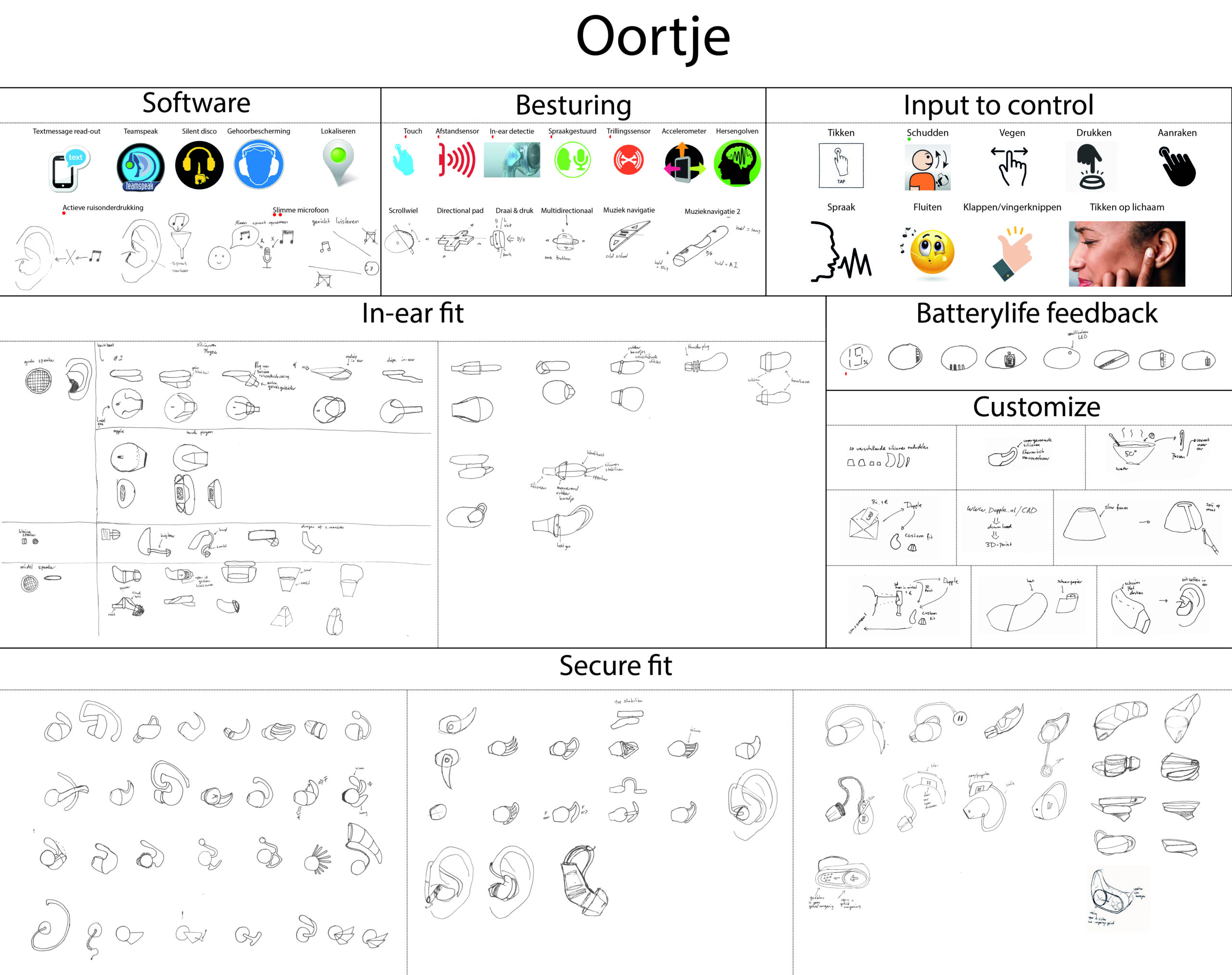
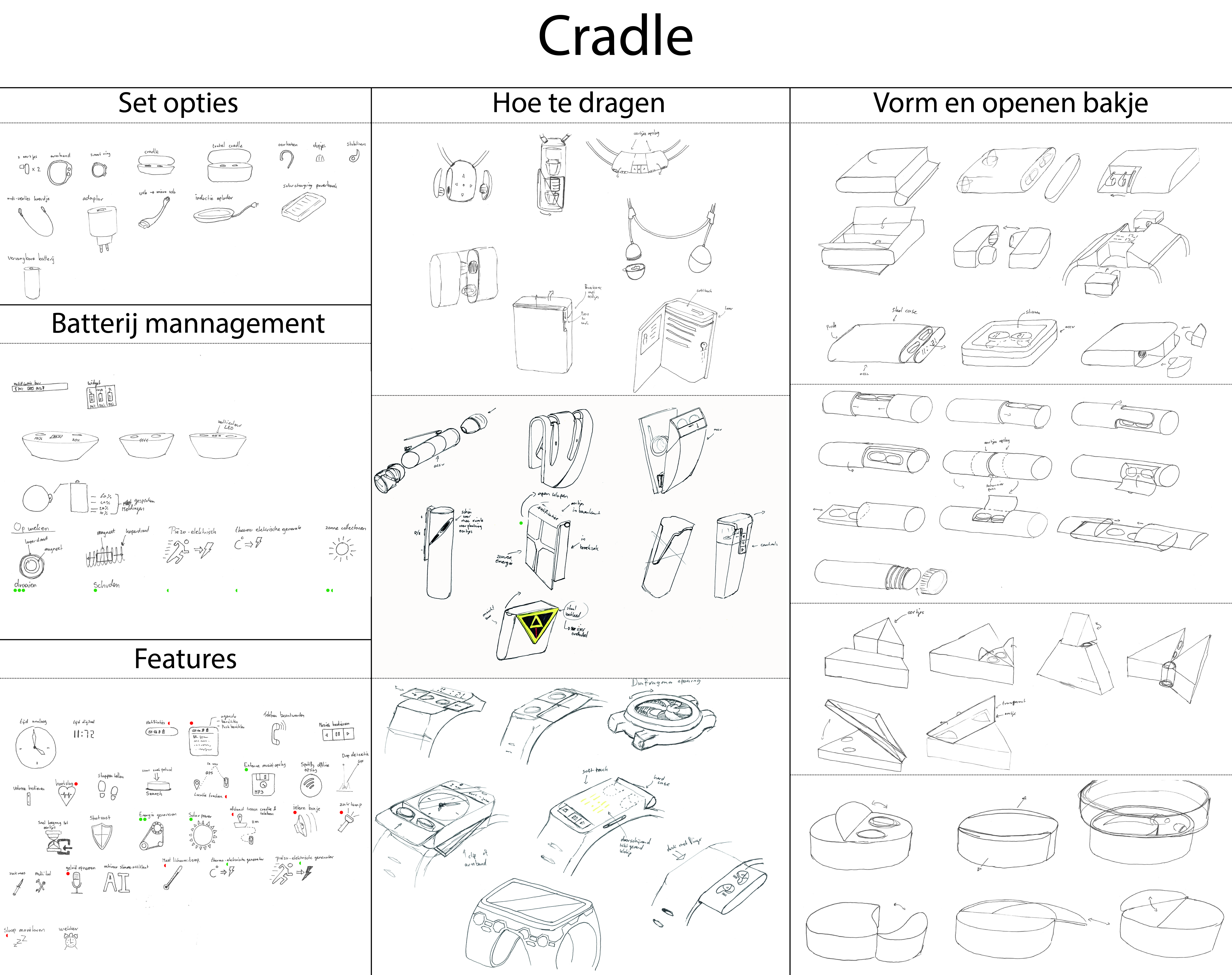
Converging to Concepts
Product Idea Formation: Based on the fundamental guidelines from the initial research and the identified needs of the target audience, 12 distinct product ideas were developed. These product ideas consolidated the broader concepts from the ideation stage into more refined solutions.
Review and Selection
The product ideas were reviewed by experts at Dopple, who identified potentially interesting elements. These elements were then further refined, tested, and ultimately presented in focus groups for consumer feedback. The findings were validated through surveys involving 70 participants, which led to the final selection of concepts that promised high consumer acceptance. This iterative process, moving from generating as many solutions as possible to selecting the most promising ones, ensured that the ideation was grounded in user needs while being broad enough to capture various innovative possibilities.
Concept Segmentation
The segmentation of the concepts was an essential step in refining the final product. Each of the selected concepts wa s broken down into distinct features and functions, which were then evaluated individually. This segmentation allowed for a detailed analysis of which specific elements added the most value to the consumer experience. By testing and discussing these segments with focus groups, Dopple was able to determine which features were most relevant and appealing, ensuring that the final product effectively addressed consumer needs while being feasible to develop. This approach helped prioritize the most impactful features, leading to a more targeted and consumer-driven product development process.

Final Concept
The creation of the final concept involved synthesizing all of the insights gathered throughout the selection and segmentation phases. Based on consumer feedback, the most valued features were integrated into a cohesive product design. Prototypes were developed to bring the concept to life, ensuring that functionality, comfort, and usability were effectively combined. The final concept aimed to provide a balance between innovative technology and user-friendly design, resulting in a product that not only met consumer expectations but also aligned with Dopple’s strategic goals.
The earpieces were designed to follow the natural shape of the ear for a secure and comfortable fit. They included features such as an accessible touchpad for controlling music, the ability to mix environmental sound with music for safety, and active noise cancellation for improved sound quality. Additionally, the earpieces had built-in storage for offline music playback, enhancing user convenience.
The cradle was designed with a sleek, robust look featuring a Zippo-style hinge for easy access and a protective silicon edge. It provided storage, charging capabilities, and also featured a speaker for hands-free calls and interaction with a smart assistant. The cradle could be charged wirelessly, and also had a solar panel, offering flexibility in different environments. The combination of wireless charging and the solar panel aimed to extend battery life without frequent recharging.
The smartphone app was an integral part of the product, providing functionalities like battery status monitoring, offline music management, and the ability to locate misplaced earpieces through GPS. The app also allowed users to adjust settings like sound equalization and active noise cancellation, giving them full control over their audio experience.
Design considerations focused heavily on user comfort, intuitive operation, and seamless integration of the different components. The earpieces were crafted to be lightweight, comfortable for prolonged use, and secure during physical activities. The touchpad controls were carefully calibrated to prevent accidental activation, and the active noise cancellation was made easily togglable to suit varying environmental contexts. Durability was also key, with materials chosen to withstand daily wear and tear while maintaining an elegant appearance. Ultimately, the final concept was designed to offer a premium user experience by blending advanced technology with everyday practicality.

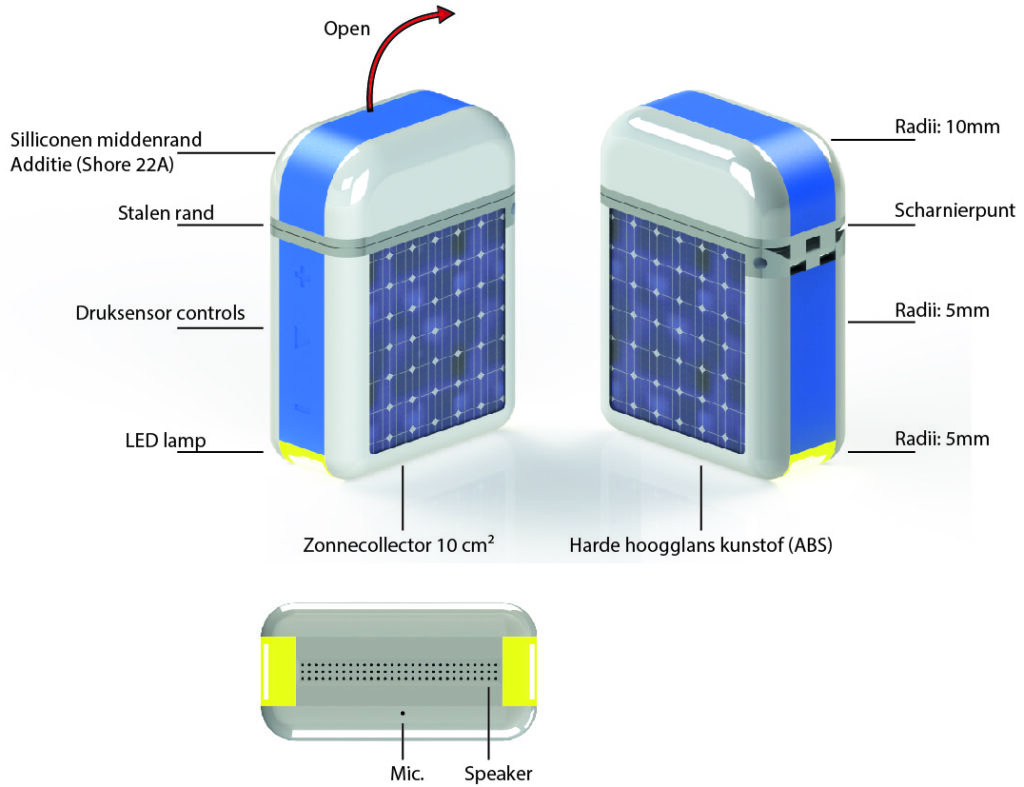
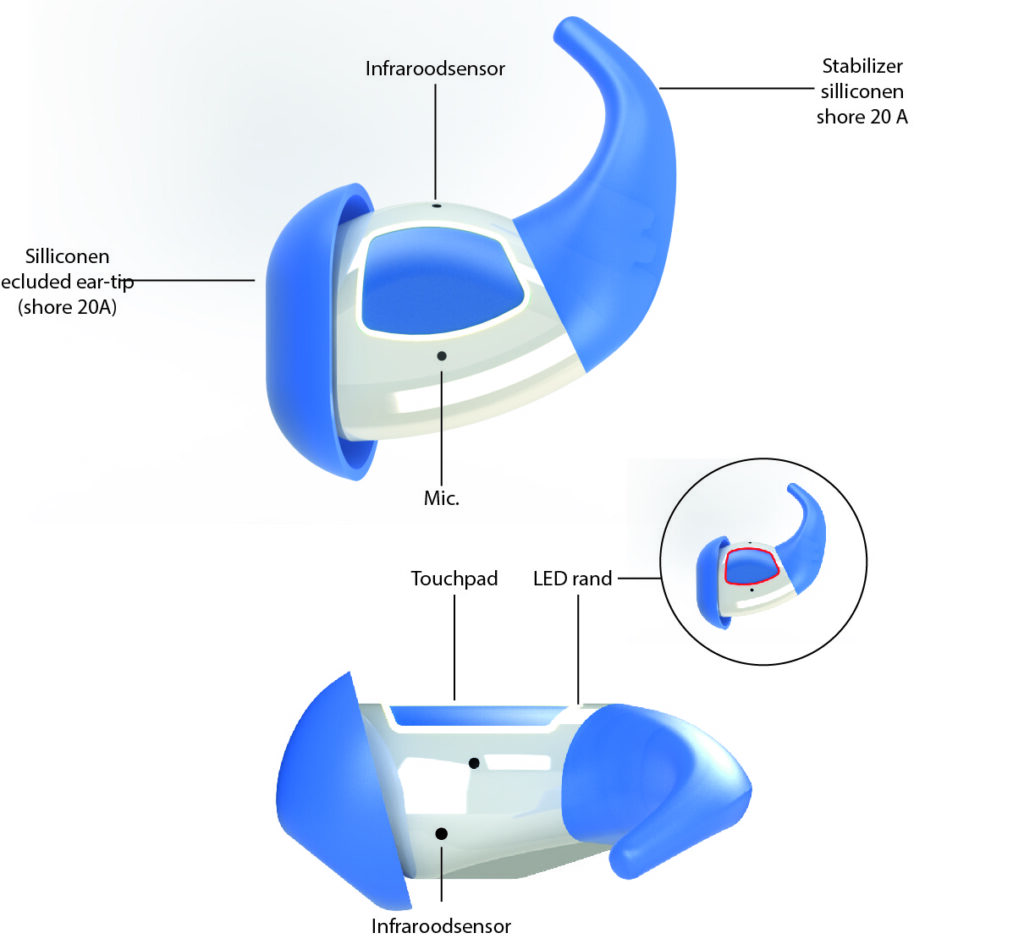
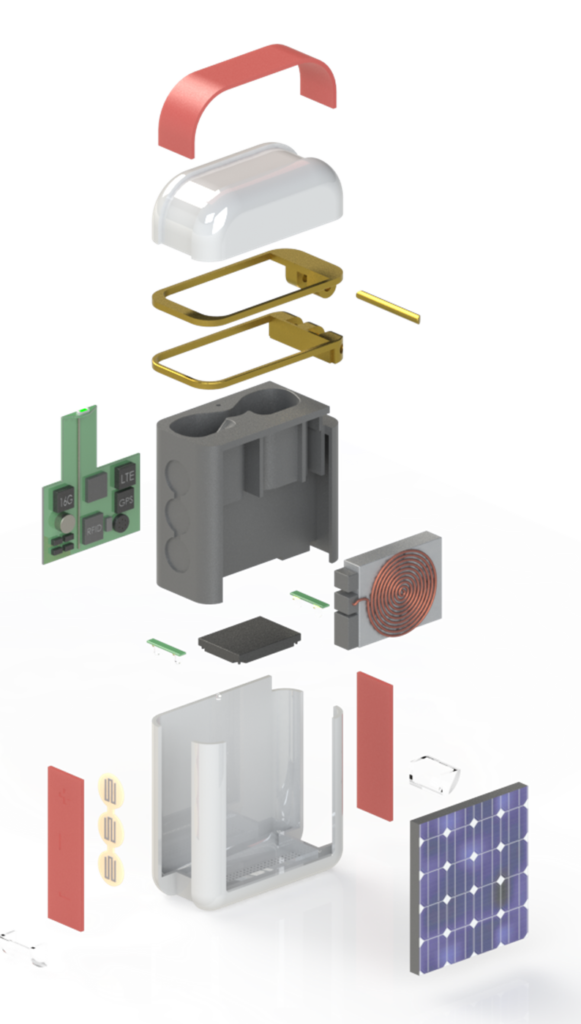
Materialization
The materialization and prototyping phase was crucial for bringing the concept to life and ensuring it met the intended design and functional requirements. Materials were chosen based on durability, comfort, and aesthetics. The earpieces were crafted using lightweight ABS plastic for strength and wear resistance, combined with silicone for comfort and fit stability. The cradle featured a protective silicon edge for shock absorption, while the casing was made from a robust polycarbonate material to withstand impacts and daily handling.
Prototypes were created using a combination of 3D printing and silicone molding techniques. The earpieces were 3D printed to test ergonomics and fit, while silicone components were molded to ensure comfort and adjustability. The cradle’s Zippo-style hinge was also prototyped to verify ease of use and robustness. Iterative prototyping allowed the design team to test and refine each component, ensuring that the final product was both functional and aligned with user expectations. The prototypes were then subjected to usability testing to gather feedback, leading to adjustments that enhanced the final product’s practicality and user experience.








Validation
A validity study was conducted after the materialization phase to evaluate whether the final concept met the desired levels of consumer acceptance. The study involved presenting the product to participants through a physical model and a simulation video that demonstrated its functionalities. Participants were asked to provide feedback on different aspects of the design, such as comfort, usability, aesthetics, and perceived value, using a structured questionnaire. The results were then compared against predefined hypotheses about consumer responses to assess if the product fulfilled its intended goals. The feedback indicated that most users found the earpieces exceptionally comfortable, although some mentioned that the limited sizing could affect the fit. Aesthetic aspects like the bright colors received mixed reviews—some appreciated the visibility, while others found it less appealing. This feedback helped confirm and refine the final design elements, ensuring the product’s features were well-aligned with user expectations.
Reflection
Reflecting on the project, I learned a lot about balancing ambition with realistic planning. At the start, my excitement for the exploration phase led me to delve deeply into research, sometimes to the detriment of maintaining a clear project direction. I learned the importance of setting boundaries during ideation to avoid getting lost in the details and to ensure timely progress. The experience also taught me the value of flexibility—when the initial plan proved insufficient, I adjusted it, incorporating insights from my research to create a more feasible roadmap.
One of my key strengths during this project was in ideation and prototyping. I found the creative phase particularly inspiring, and the structured approach using a morphological map helped ensure that all generated ideas aligned with user needs. The prototyping phase allowed me to leverage new skills with advanced 3D printing and silicone molding, which was both challenging and rewarding. However, I also learned the risks of perfectionism—particularly during the prototyping phase and preparing for key presentations, where I sometimes spent too much time on details. This has highlighted the need for me to strike a balance between quality and efficiency.
Looking forward, I recognize the importance of pacing myself to prevent burnout. My passion and drive are assets, but they also have the potential to lead me into a hyper-focused state where I lose track of time and over-invest energy. Regular reflection and creating deliberate breaks will be crucial for managing my energy levels and maintaining a healthy work-life balance. I also plan to further develop my skills in project setup and research methodologies to ensure a stronger foundation in future projects. The lessons learned from this project will guide me in making my future work both impactful and sustainable.











